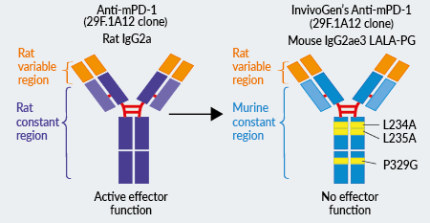Anti-mPD-1-mIgG2ae3 (29F.1A12)
-
Cat.code:
mpd1-mab19-1NEW
- Documents
ABOUT
Recombinant effectorless (LALA-PG) mouse PD-1 antibody in InvivoFit™ grade
Anti-mPD-1-mIgG2ae3 InvivoFit™ is a recombinant murinized mAb designed for in vivo studies in mice. This monoclonal antibody (mAb) features the variable region of the rat-derived clone 29F.1A12 and a mutated (LALA-PG) mouse IgG2a constant region for no effector functions. It blocks the binding of mouse programmed death-1 (mPD-1) with its ligands, PD-L1 and PD-L2.
The original anti-mPD-1 clone 29F.1A12 was obtained by immunizing rats with cells expressing mPD-1 [1]. The use of xenogeneic sequences (i.e. rat origin) for mAbs renders them immunogenic upon injection in mice. In fact, repeated administrations of such rat-derived mAbs often trigger host anti-rat immune responses, which can compromise antibody efficacy or lead to immunogenic events. To overcome these issues and improve in vivo performance, the original rat-derived constant region was replaced with an effectorless mouse IgG2a constant region (IgG2e3), making it approximately 65% of murine origin. Anti-mPD-1-mIgG2ae3 contains three point mutations in the Fc region at positions L234A, L235A, and P329G, referred to as LALA-PG. These mutations result in the complete loss of unwanted Fc-associated effector functions.
Together, these design characteristics make Anti-mPD-1-mIgG2ae3 ideally suited for in vivo studies, enhancing both safety and experimental reproducibility.
Key features
- Each lot is functionally tested and validated
- The complete sequence of the antibody construct was verified.
- The absence of endotoxins was determined using the LAL assay
- InvivoFit™ grade: specifically designed for in vivo studies in mice
Applications
- In vivo experiments
- Fc-mediated effector function studies
- Comparable studies using different anti-mPD-1 mAbs
Programmed cell death ligand 1 (PD-L1; also called B7-H1 or CD274) binds to programmed cell death protein 1 (PD-1) on T cells and contributes to T cell exhaustion during chronic infections. Moreover, the engagement of PD-1 on T cells and PD-L1 on malignant cells is associated with tumor immune escape. Clinical trials have highlighted the anti-tumor efficacy of blockades targeting the PD-1/PD-L1 pathway.
1. Horwitz BH, Freeman GJ, Sharpe AH. 2003. Regulation of PD-1, PD-L1, and PD-L2 expression during normal and autoimmune responses. Eur J Immunol.;33(10):2706-16.
All products are for research use only, and not for human or veterinary use.
InvivoFit™
InvivoFit™ is a high-quality standard specifically adapted for in vivo studies.
InvivoFit™ products are filter-sterilized (0.2 µm) and filled under strict aseptic conditions in a clean room. The level of bacterial contaminants (endotoxins and lipoproteins) in each lot is verified using a LAL assay and a TLR2 and TLR4 reporter assay
SPECIFICATIONS
Specifications
PD-1, CD279
Mouse
In vivo studies, flow cytometry
Sodium chloride, sodium phosphate buffer, saccharose
< 5%
0.2 µm filtration
< 1 EU/mg (measurement by kinetic chromogenic LAL assay)
Flow cytometry
Each lot is tested by flow cytometry.
CONTENTS
Contents
-
Product:Anti-mPD-1-mIgG2ae3 (29F.1A12)
-
Cat code:mpd1-mab19-1
-
Quantity:1 mg
Shipping & Storage
- Shipping method: Room temperature
- -20 °C
- Avoid repeated freeze-thaw cycles
Storage:
Caution:
Details
Immune checkpoint signal: PD-1 and PD-L1
— PD-1 (programmed cell death 1; also known as CD279) is a type I transmembrane protein expressed at the cell surface of activated and exhausted conventional T cells. PD-1 is an inhibitory immune checkpoint that prevents T-cell overstimulation and host damage. PD-1 interaction with its ligands PD-L1 and PD-L2 induces inhibition of TCR signaling [1].
— PD-L1 (programmed cell death ligand 1; also known as CD274 or B7-H1) is a transmembrane protein expressed at the cell surface of hematopoietic and non-hematopoietic cells and is induced by pro-inflammatory cytokines, such as in the tumor microenvironment [1]. PD-L1 is one ligand for PD-1, an inhibitory immune checkpoint receptor that is expressed by activated and exhausted T cells. PD-1:PD-L1 interaction induces inhibition of TCR signaling, thereby preventing T-cell overstimulation and host damage [1].
PD-L1 expression is an immune evasion mechanism exploited by various malignancies and is generally associated with poorer prognosis [2]. Specifically, over-expressed PD-L1 on tumor cells and tumor-infiltrating immune cells, such as macrophages, can bind to PD-1 on cytotoxic T cells, and ultimately inhibit the anti-tumor T cell response [3, 4]. Thus, due to PD-L1’s instrumental role in immune evasion by cancer cells, there are numerous inhibitors in development as promising immuno-oncology therapies. Notably, Atezolizumab (also known as MPDL3280A), a fully humanized IgG1 (N298A) mAb that blocks the interaction of PD-L1 with PD-1 and induces anti-tumor immune reactivation, has been approved by the FDA for combinational use in the treatment of lung and breast cancer [3, 5].
References
1. Ribas A. and Wolchock J.D., 2018. Cancer immunotherapy using checkpoint blockade. Science. 359:1350-55.
2. Sun, C. et al. 2018. Regulation and Function of the PD-L1 Checkpoint. Immunity 48, 434-452.
3. Kythreotou, A. et al. 2018. PD-L1. J Clin Pathol 71, 189-194.
4. Lau, J. et al. 2017. Tumour and host cell PD-L1 is required to mediate suppression of anti-tumour immunity in mice. Nat Commun 8, 14572.
5. Heimes, A.S. & Schmidt, M. 2019. Atezolizumab for the treatment of triple-negative breast cancer. Expert Opin Investig Drugs 28, 1-5.
DOCUMENTS
Documents
Technical Data Sheet
Safety Data Sheet
Validation Data Sheet
Certificate of analysis
Need a CoA ?





